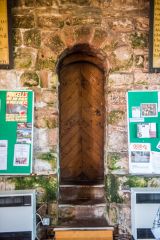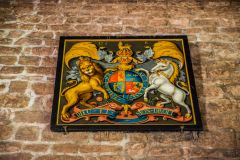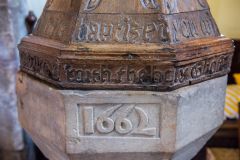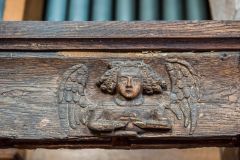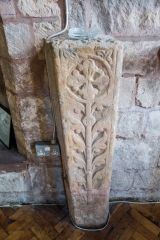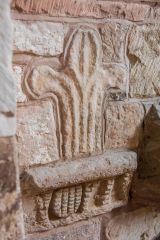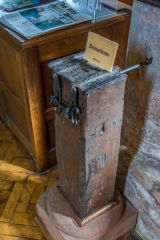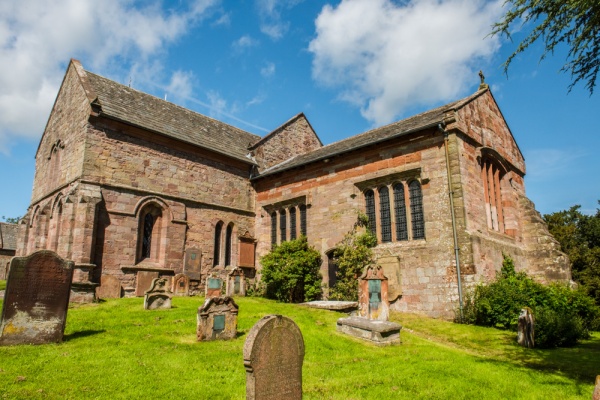
St Lawrence church in the pretty village of Morland is one of the most intriguing historic churches in Cumbria. The highlight of the church is the Saxon tower, the only pre-Norman tower in Cumbria.
Like most early towers, it served both religious and military purposes, providing a useful place to watch for approaching raiders and a safe place to take refuge when raiders approached. The walls are up to 5 feet thick, a reminder of how violent and precarious life could be so close to the border between Scotland and England.
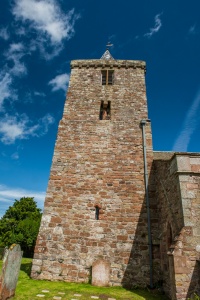
History
The tower is accessed through a narrow round-headed Saxon arch from the nave. Niches on either side of the arch show where timber beams were inserted to reinforce the door against invaders. Three narrow lancet windows scarcely provide any light, but they would have made the tower a safe place to take refuge.
Higher up the tower the windows become wider, in the traditional double-headed Saxon design with a central shaft. The top of the tower was raised in the 17th century but the original parapet was reused. Internally, there are 3 bells, dated 1696, 1727, and 1764, reached by a worn timber ladder made in 1673 from a single oak tree.
The nave is 12th century, built to replace the earlier timber nave. In the 13th century it was enlarged with aisles and transepts. One of the original 12th-century piers remains, while the other piers are 13th century. You can still see the 12th-century roof line from the exterior. Look for carved stones in the traditional Norman chevron pattern that have been inset in the north aisle and north transept windows.
Panels from 17th century box pews are set against the west wall. One striking feature are the large Georgian windows in the north aisle, a very unusual sight in what is essentially a Saxon and medieval building. The elegant windows are split with lead glazing bars and rise to the rounded top beloved by Georgian architects.
One of the most interesting historic remains is an oak poor box on a wooden pedestal near the south door. The poor box was carved in 1648 and is still used as an alms box.

The chancel is 13th century, with side chapels to the north and south. The south chapel was walled up during the Reformation but the north chapel survived and now houses the organ. Wooden screens separated both chapels from the chancel, but these have now been moved behind the choir stalls. The screens date to at least the 14th century and are decorated with small human heads, perhaps representing clergy and parishioners of the period.
Apparently the church was in a very poor state during the 18th and early 19th centuries, so much so that the exterior was covered in ivy 5 foot thick, which forced its way through the walls and grew inside the church.
The church's condition was so bad that a visitor wrote in his diary that the text from Genesis, "How dreadful is this place", which was painted on a board over the door, was an apt description of the church. Thankfully a restoration in 1896 swept away the ivy and sensitively restored the building so that today we can enjoy one of the most interesting and historic churches in Cumbria.
Visiting
St Lawrence stands in the centre of the village, and there is parking along the streets nearby. The church is normally open daylight hours and stands immediately beside Morland House, a Tudor house with a 4-acre garden regularly open to visitors.
About Morland, St Lawrence Church
Address: Church Lane,
Morland,
Cumbria,
England, CA10 3AZ
Attraction Type: Historic Church
Website: Morland, St Lawrence Church
Location
map
OS: NY598225
Photo Credit: David Ross and Britain Express
HERITAGE
 We've 'tagged' this attraction information to help you find related historic attractions and learn more about major time periods mentioned.
We've 'tagged' this attraction information to help you find related historic attractions and learn more about major time periods mentioned.
Historic Time Periods:
Find other attractions tagged with:
12th century (Time Period) - 13th century (Time Period) - 14th century (Time Period) - 16th century (Time Period) - 17th century (Time Period) - Decorated (Architecture) - Georgian (Time Period) - Medieval (Time Period) - Norman (Architecture) - Pre-Norman (Architecture) - Reformation (Historical Reference) - Restoration (Historical Reference) - Saxon (Time Period) - Tudor (Time Period) -
NEARBY HISTORIC ATTRACTIONS
Heritage Rated from 1- 5 (low to exceptional) on historic interest
Morland House Gardens - 0.1 miles (Garden) ![]()
Bolton, All Saints Church - 2.6 miles (Historic Church) ![]()
Acorn Bank - 3.7 miles (Garden) ![]()
Lowther Castle and Gardens - 4.7 miles (Historic House) ![]()
Clifton Hall - 5 miles (Historic Building) ![]()
The Countess Pillar - 5.1 miles (Historic Building) ![]()
Brougham, St Ninian Ninekirks - 5.2 miles (Historic Church) ![]()
Appleby, St Lawrence Church - 5.4 miles (Historic Church) ![]()
Nearest Holiday Cottages to Morland, St Lawrence Church:
More self catering near Morland, St Lawrence Church
